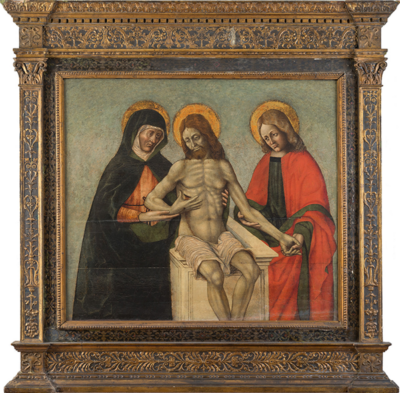La Salle University
Sixth Week of Lent Reflection
Looking at the art:

Man of Sorrows
15th Century
32 3/4 x 36 7/8 in. (83.2 x 93.7 cm)
Paduan School, Italian, b. 15th Century
Object Type: PAINTINGS
Creation Place: Europe
Medium and Support: Tempera, oil on panel
Credit Line: Gift of Dr. William Serri
Accession Number: 70-P-75
Current Location: Art Museum : 15-16 C Gallery
The Man of Sorrows motif owes its name to the Suffering Servant image in Is. 53:3 (“He was despised and rejected, a man of sorrows and acquainted with grief.”) Jesus as Man of Sorrows is typically depicted as semi-naked from waist up with wounds inflicted by a crown of thorns, nails, and spear piercings from which blood flows freely. Our depiction includes Jesus sitting on the edge of his tomb and flanked by his mother Mary and beloved disciple John. It is almost as if to portray a visit to the tomb where Mary and John give Jesus an assist as he balances himself on the edge of the tomb. This scene is of course detached from the narrative of the Passion and is not scripturally supported. It is however consistent with an aesthetic that embellishes scriptural scenes with a human touch. Follow the direction of the arms and you will see the gentle touch of fingers around Jesus’s rib cage, on his elbows and in John’s left hand.
The painting bears a certain resemblance to Eastern icons. There are of course the gilded halos and also the plain background that provides no depth. The Paduan school (near Venice) was at the crossroads of trade with the East and was known for its sharp, clear human forms which are visible closeup in the facial structure of the figures that are notably devoid of expression but nonetheless inspirational.
Reflection
It is finished. We have come to the end and here is the body of Jesus ready for burial. There are several scripture scholars who believe that the early disciples, reflecting on the death of Jesus, concluded that by the Friday evening the world had been changed permanently and for the better; the revolution had begun. Why would they have thought this? They saw the Resurrection as the first fruits of what happened Friday; it is the death of Jesus that was central to them. As I have reflected on this and have reflected on where the gospel writers focus our attention, I have come to understand the distinction between the fact that Jesus suffered physically and the suffering that he took on himself, the suffering of the world. Whatever suffering we experience, because of our separation from God, Jesus experienced and took it into himself where it is ultimately transformed. The anxiety that he suffered at his approaching death and the finitude of the death that he was to experience are human emotions that all of us experience. As a human being Jesus would have experienced all these emotions. As God, he would also have added the sufferings that he took on himself. These would have been emotional and psychological, the sweating of blood. Indeed, we have here a Man of Sorrows. It is only by taking on all this that there can be a passage to something different. It is the mystery of God that suffering is relieved by accepting it, taking it on, not by avoiding it. Accepting it we come out the other side redeemed. I, we are redeemed, not rescued. God does not rescue Jesus from the cross but on the other side redeems him, the Resurrection answers the suffering in a profound and direct way. So, with us, we are all men and women of sorrow. God does not rescue us, but God will redeem us.
We all suffer and will suffer no matter where our stories take us. I know that I do my best to avoid suffering and pray to be rescued. I know that I cannot take on the Mantle of the Sorrowful one. That is not the message of the cross. I have been trying to learn the message of the cross, but it is hard. I would prefer to be rescued. That is safe; I know where I am and where I will be. Being redeemed is scarier since it takes me into the unknown. But what surprise waits in redemption!